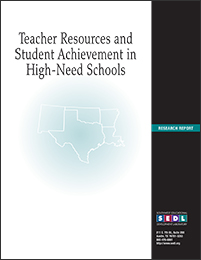Teacher Resources and Student Achievement in High-Need Schools

Authors: Debra Hughes Jones, Celeste Alexander, Zena H. Rudo, Diana Pan, Michael Vaden-Kiernan
| Price: Available free online |
Available online: PDF
![]()
With the growing federal, state, and local policy emphasis on teacher quality and student achievement, the Southwest Educational Development Laboratory (SEDL) investigated teacher resources and their relationship to student achievement in Arkansas, Louisiana, and Texas. The purpose of this study was to provide policymakers with information about the relationship between teacher salary, experience, and education, and the relationship between these teacher resources and student achievement, particularly in high-need schools. SEDL used state databases in Arkansas, Louisiana, and Texas to examine the extent to which districts paid teachers based on years of experience and degree level, and whether teacher resources, defined as salary, education, and experience, were distributed differently across schools depending upon their level of need. SEDL also investigated whether within and across the three study states paying teachers based on experience and education contributed to student achievement test scores, specifically on elementary and middle school reading and math tests. SEDL answered three research questions.
- To what extent do teacher experience and education relate to teacher salary?
- Teacher experience and education are the primary factors that contribute to teacher salary levels.
- Variations in teacher salaries exist in schools that are located in rural settings, are populated by high-poverty and a high percentage of minority students, and have low student achievement.
- An overall pattern in the data revealed salary increases along a typical "step and ladder" structure for education and experience Teacher Resources and Student Achievement
- Do teacher salary, experience, and education vary for different categories of high need schools and between high-need and non-high-need schools?
- Schools that are low performing, have high concentrations of student poverty and minority students, and are located in rural settings, tend to have less qualified teachers.
- The rural location of schools was more "high-need," by definition, than the urban location in the three states studied.
- The strongest finding across states revealed that schools in rural locations, in conditions of high poverty and low achievement in math, were staffed with the lowest paid teachers, with lower percentages of graduate education, especially compared to urban schools.
- What effects do teacher salary, experience, and education have on student achievement, particularly in high-need schools?
- The findings linking teacher education and experience to student achievement are minimal, leaving little to be said about the influence of teacher resources on student achievement in reading and math.
- Of the teacher resources, teacher salary was related to student achievement in math and reading in Texas, and to student achievement in reading in Arkansas.
- Teacher education beyond the undergraduate degree had no relationship to student achievement in reading and was found to be negatively associated with math scores only in Texas.
- Findings for teaching experience were likewise inconsistent.
- There were few significant findings related to high-need schools; teacher education beyond the undergraduate degree was negatively associated with fourth-grade math scores in rural and high-poverty schools and the findings for teaching experience were inconsistent.
